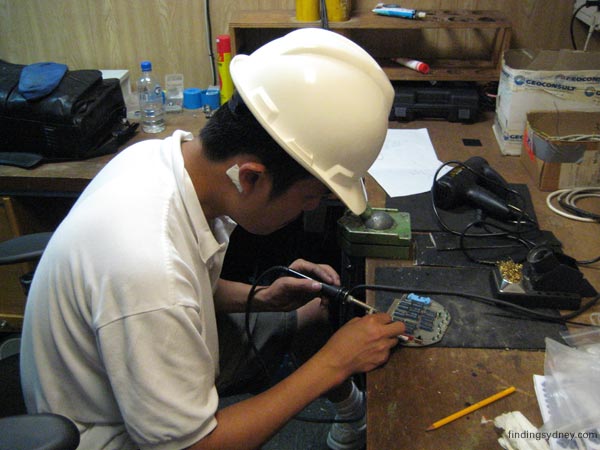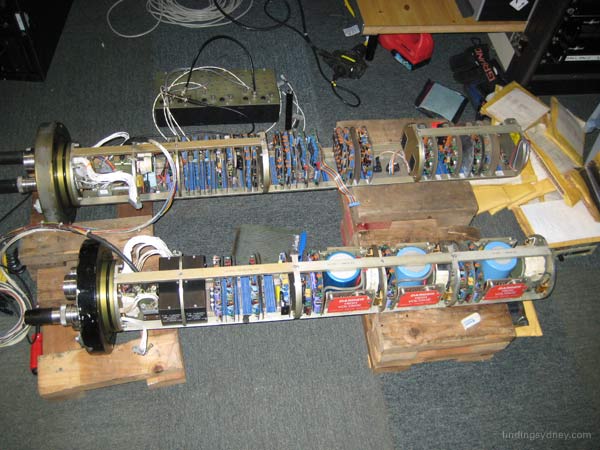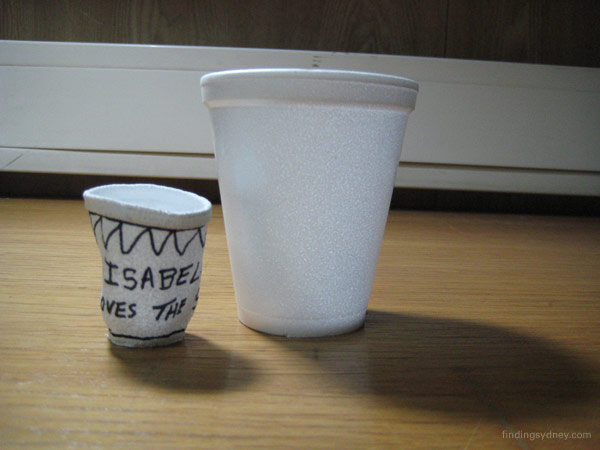David Mearns - Seach Director, The Finding Sydney Foundation
When I said yesterday that more twists and turns were to come I wasn't expecting them to come so fast. The first twist was a particularly cruel one. Towards the end of our first sonar trackline it was clear that the SM30 towfish was having some problems that affected the quality of the sonar imagery being produced and had to be recovered for repairs. One immediate problem was solved straight away when an electrical cable was found to be nicked allowing seawater to penetrate the cable and cause short circuiting. The offending cable was easily replaced.
The remaining problems were far trickier to troubleshoot as they involved the delicate electronics of the SM30 towfish that are the domain of Carter Le, the electronics engineer who is a key member of the Williamson & Associates sonar team. Carter worked many hours throughout the day finding and fixing two faults after which the only thing left to do was deploy the towfish again to see if the imagery was good enough to resume searching. Several hours later and with 6,000 metres of towcable deployed the turn we dreaded had just taken place.
Tropical Cyclone Ophelia, a category 1 storm packing gale force winds decided to change course and turn directly for our location. Whilst it is hard to find a silver lining as a cylcone bears down on you I am grateful that Ophelia is nothing like as severe as the Western Atlantic Hurricanes I am used to. Still we are facing certain weather downtime, which although expected and budgeted for, is hurtful to our progress at this early stage in the search. There is an old saying that the sea doesn't give up her secrets easily and it appears that Ophelia has dropped in to remind us of that.

Above Photograph - Carter Le, Williamson & Associates Electronic Engineer making repairs to a printed circuit board

Above Photograph - the two electronics racks of the SM30 sonar towfish

Above Photograph - the 9pm track of Tropical Cyclone Ophelia relative to our current position

Above Photograph - two polystyrene cups, before and after being squeezed by several thousand metres of water pressure.

Above Photograph - seas following passing of Cyclone Ophelia
John Perryman - Senior Navy Historian (Observer)
Today I witnessed first hand just how much pressure is exerted on the side-scan sonar equipment when it is operating in very deep water.
Prior to its launch before the first run, the Williamson crew placed a number of polystyrene cups, which they had written their names on, in a small bag attached to the sonar. When it was recovered, the cups were retrieved but had been compressed in size to about one third of their original size. Apparently this is due to the air being squeezed out of them by the intense water pressure. Many of the cups had been adorned with artwork and logos and they will no doubt become memorable souvenirs of this expedition.
With some minor repairs required on the sonar, today was fairly quiet, however it is expected that it will soon be re-deployed as we commence another run through the search box.
For more information concerning HMAS Sydney (II) visit: www.navy.gov.au/spc and visit the ship history pages.
IMPORTANT NOTICE: The Material (including photographs) available in the "Press Room" section of this Website may be used/reproduced unaltered by your organisation (unless stated otherwise within the content description) subject to the terms and conditions set out in the Legal Section AND any Material (including photographs) which you use/reproduce must credit the source as "The Finding Sydney Foundation" and, as an option, you may also link the source statement with the website address http://www.findingsydney.com/.